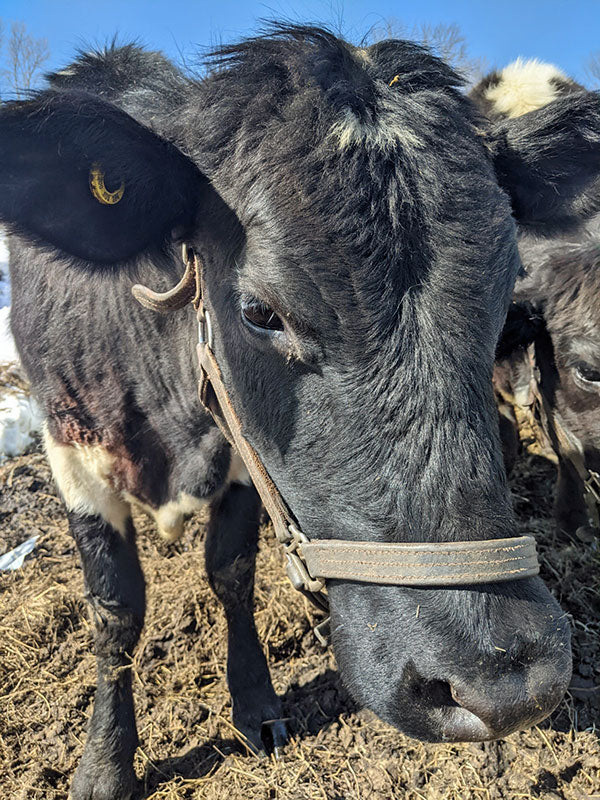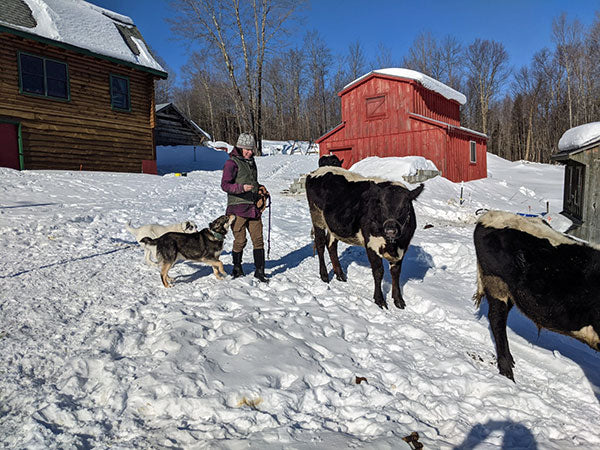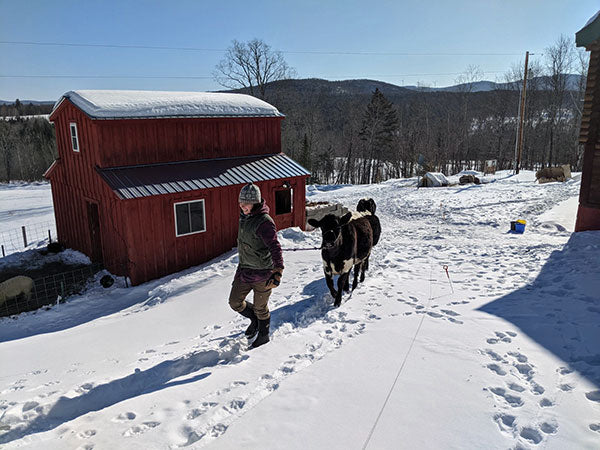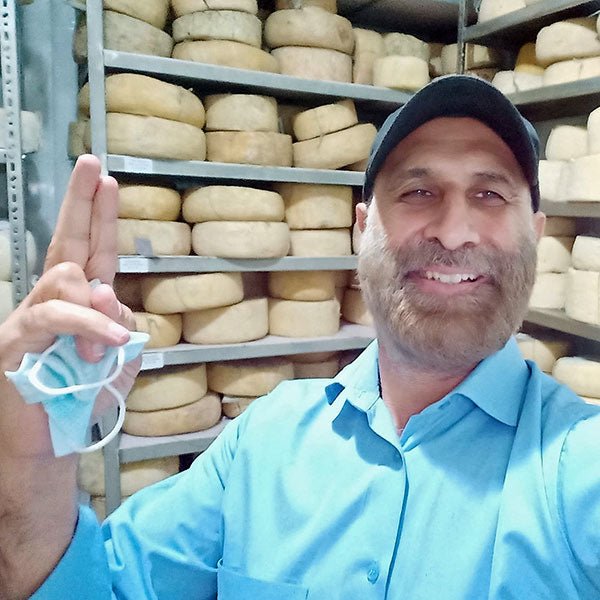Hilary Elmer is a homesteader in northern Vermont. She makes cheese, grows vegetables, raises cows, pigs and chickens, hunts and dresses animals herself – all while running a household (in a log cabin) with her husband, Kevin and her 2 children – Ephraim (13) and Hannah (15). She plans to open a small dairy soon (Between the Trees Heritage Dairy) where she will sell cheese, butter, yogurt and raw milk.
April 1st we featured Hilary Elmer in our monthly Moos-Letter. She was our “Spotlight” with a brief introduction and a link to a blog article about her (click here).
During the course of our interview, Hilary told us that she used to have goats but she is now raising Lynch Linebacks, a rare, landrace breed of cows. We thought you might be interested in knowing more about her (very) difficult decision to change direction.
Heritage Breeds and My Quest for Self Sufficiency
By Hilary Elmer
Like many people who grew up in modern America, as a kid I dreamt of having a farm and living off the land someday. My idea of what that would look like has changed a lot over the years, but the one thing that remained constant was that I wanted to produce all of my family’s food without any outside inputs.
When we started our farm in 2006, we were really more of a homestead, trying to grow our family’s food but not yet selling to the community. As soon as we had built our house, my husband Kevin built a little goat shed and I got my first couple of goats. I was super excited!
I knew nothing about raising livestock at the time, but goats were cute and small enough that I felt comfortable handling them (compared to cows). I got a how-to-raise-goats book, found a farmer to buy hay from, and got bagged pelleted grain from the feed store.
I didn’t like having to buy animal feed to make milk, but it was a start. Of course, I also began gardening, and I was delighted to have the goat manure to compost my garden.
Feeding
I wasn’t content buying grain for my goats for long. Or hay. What I really wanted was to grow my goats’ food.
It is possible to grow enough hay for a couple of goats. Two goats eat about 60 square bales every winter here in Vermont, and that is within the grasp of a homesteading family to produce themselves. But what about the grain? And, yeah, what about grain—why not grass fed, with no grain? Is grain really necessary? My quest for self-sufficiency was about to lead me down a path I had never suspected.
Something that I used to like about dairy goats, besides their fun personality and unimposing size, was that they produce so much milk compared to their body size and how much hay they eat.
They are efficient. Efficient is a good thing, right? Well… what I didn’t realize quite yet is that, like modern Holstein cows in an industrial dairy, modern dairy goats require supplements of grain and protein with their forage and hay. Their bodies work so hard making milk that they would milk themselves to death without supplements.
All animals that produce a lot of milk for their body size are that way—cow, goat, or any animal. Heavy milkers also walk a tight line with minerals. They require lab-formulated mineral mixes to meet their exact demands.
Concentrates
The bagged, pelleted feed at a store is known as concentrates. Concentrates are a concentrated source of carbohydrates, protein, and minerals, ground up and delivered in an easy, no brainer solution.
Do concentrates work? Well, maybe, depending on your goals. If you want an easy option for a heavy milking animal, it’s great. But here’s the catch, or should I say catch-22: concentrates aren’t actually good for livestock.
Grazing animals were never meant to eat large amounts of grain; have you seen the size of wild grass seed compared to domesticated grain? And they should only eat as much protein as you find in lush grass. The grain in concentrates causes acidosis, while the soy protein in it creates high urea levels in the blood, which lead to all kinds of health problems.
My goats were not thriving on concentrates; mastitis and hoof rot were common, births were not easy. And let’s not forget that many homesteaders, like me, are concerned about the environmental impact of farming. The concentrates that you buy are farmed in tilled soil, often fertilized with chemicals, using fossil fueled equipment, and shipped hundreds of miles to you.
While I maintain that grass fed farming is good for the environment and climate, I’m not sure that feeding large amounts of concentrates to dairy animals is environmentally friendly. Not to mention that if you want to be self-sufficient, buying feed bags just isn’t it.
Homemade Options
So, I began experimenting with home grown “concentrate” options. I started growing veggies, which seemed like a good alternative to grain. I gave the goats a couple pounds of vegetables such as carrots, beets, or pumpkins every day. They milked well enough, and they really loved the veggies.
The best part was that when kidding time came, instead of flaccid, limp kids at birth, and the mothers being exhausted after the birth like when they were on conventional pellets, the kids were on their feet in minutes and the mothers had energy. Also, the mastitis and hoof rot went away. I was so happy with the improvements in goat health!
It wasn’t all great, though. I had to grow a much, much bigger garden, which took enormous amounts of my time. And I found that my goats were having trouble breeding back. They weren’t even coming into heat. Apparently they were not getting enough nutrition. Remember, heavy milkers need more than just some extra carbs, they need scientifically formulated blends.
It’s funny to hear farmers say, “It’s always the best milkers that get sick,” as if it’s a surprise. Think about that statement. What does it say about their expectations for their animals? It makes the assumption that heavy milkers are the best milkers at all cost. Are heavy milkers really the best milkers if they are the ones that get sick, require the most inputs, and die young?
Around the time that I was getting frustrated with my goats’ inability to breed, they jumped the fence one too many times. I remember going on a walk with my husband, crying and frustrated. I loved my goats and I wanted dairy animals, but something just wasn’t working.
I was thinking about trying a different goat breed, but he reminded me that even if they supposedly did well grass fed, they would still jump fences. I had never wanted cows, but he convinced me to give cows a try. Goats are notoriously hard to keep in a fence, while cows can (miraculously) be kept in a single strand of electric. (To this day, I wonder what would have happened if I have tried Golden Guernsey goats, which supposedly do well on grass. To anyone looking into self-sufficient, grass fed goats, I recommend you look at that breed.)

Golden Guernseys, an endangered breed of goats, originally from the Channel Islands in Great Britain. (Photo from Wikipedia)
A Change
We started researching heritage cow breeds. Suddenly the stars aligned in my sky, and I realized what had been missing from my attempts at self-sufficient dairying. It was the efficiency factor!
Modern dairy breeds that make a lot of milk require too high of production for the poor animal to produce without a modern diet supplemented with concentrates. What we needed was a heritage breed, or a breed that has remained largely unchanged over the past couple hundred years. A breed that doesn’t make more milk than it can handle on grass alone.
You see, over the past hundred years or so, industrial farming methods made grain cheaply available to feed livestock, not just people. The combination of large amounts of grain and artificial insemination allowed intense breeding for animals that produced much more milk than animals ever had before. Livestock became specialized into “dairy” or “meat” breeds.
When artificial insemination became widely available in the 1960’s the landrace/heritage breeds across the country started disappearing as farmers upgraded their animals to higher producing stock. If you look at a Holstein Friesian cow from 1960, you will see they look much more balanced than they do today. They weren’t just skin and bones with a huge udder. They had more flesh and a modest udder.
Our Lynch Linebacks
Kevin did some research online and found a critically endangered heritage breed that he thought would fit our lifestyle perfectly – Lynch Linebacks.
Lynch Linebacks are descended from an old breed, Gloucesters, which came to this region (actually upstate New York/southern Ontario) back with the original settlers who were presumably from Gloucester, England. Over generations they selected for the animals that did well around here. They weren’t really an official breed, they were just the animals that everyone kept, which is the definition of a landrace breed.
In the 1960’s there was this guy, Robert Lynch, who saw the landrace cows that his family and neighbors had kept for generations, disappearing. He liked his cows and he didn’t want to upgrade. So for fifty years he kept a closed herd.
As he got older, young farmers who were interested in heritage breeds found his herd and disseminated them among a group of farmers dedicated to preserving the breed. DNA tests have been done on them and prove that although they look similar to American Gloucesters, which breed has been “improved” over the years, Lynch Linebacks remain distinct.
Lynch Linebacks do not produce enough milk to be considered economically viable by big farms. And yet, Linebacks and cows like them have been economically viable on small farms for hundreds of years.
Why did farmers of yesterday find them a benefit to their farms while industrial farms today can’t make space for them? That’s a complicated question, but at least one reason is that small farms used to be diversified.
Diverse farms spread the profit over many crops that benefit each other. For instance, on a diverse farm, the pigs drink excess whey and milk from the dairy, reducing the need of grain for the pigs, the vegetable garden utilizes the winter manure, and chickens get much of their feed from flies in manure and scraps missed by larger animals. Every plant and animal contributes to the good of the whole, like a healthy ecosystem.
It wasn’t until bulk tanks on farms became a requirement to sell milk that some farmers began to specialize in dairy and others forsook it altogether. Specialization meant that a farmer had to make the majority of their income off of just one thing, which means maximizing profit from that one thing. Monocrops require huge inputs, and they don’t give or receive support from sister crops. “Get Big or Get Out!” becomes the mantra. Cows start getting bred to be an udder on legs that require enormous amounts of grain and live short, unhealthy lives.
Did you know that the average age of a cow in an industrial dairy is only 4.5 years old? Half of that time they aren’t even milking yet. Dairy farmers have a high suicide rate compared to the national average.
Even when specialized dairy farms try to maximize milk production, they still have a hard time making ends meet. Farm after farm sells out, giving way to mega farms with tens of thousands of cows. Industrial dairy farming isn’t sustainable for the farmers, for the cows, or for the environment.
Heritage breeds that produce less milk, but eat high quality grass and hay with little to no concentrates, enjoy healthy long lives well into their teens. It is my opinion that dairy needs to go back to its roots of small diverse farms.
Working Together
My relationship with my Lineback cows is beautiful and symbiotic. Honestly, they don’t really need me. I believe that if they roamed freely they would do just fine.
But, with my stewardship and management of moving them to a new paddock each day, their grazing causes the pasture to improve each year. I am using them to turn young woodlands into silvapasture, which is the most productive biome for both livestock and wildlife. Bears, deer, rabbits, foxes will all benefit from my cows’ presence.
Each year of grazing increases the organic matter in the soil, the depth of topsoil and water penetration and retention improves. Every acre of rich topsoil pulls tons of carbon out of the atmosphere. All of this while providing nutrient-dense food for my family and community, and the cows are happy to do it! Regenerative farming is good for the environment, the consumer, and the animal.
So, now I have a little starter herd of Lynch Linebacks. I love my cows. Handling cows isn’t as scary as I thought, even though they are a lot bigger than me. I have learned that cows are very Zen; the trick is to work with them. Have a routine that they are familiar with, make what they want the same thing that you want. Implement changes gradually. Because we want to help conserve the breed, we are going to have more than just a family milk cow.
We are opening a micro dairy which will have five to ten producing cows, and we’ll sell breeding stock to other homesteaders who want a self-sufficient animal. The only problem is, we will never grow enough hay for this many cows’ winter diet. They eat waaayyyy more hay than a couple of goats!
I’m ok with that, now. I have come to realize that just as the crops and animals on my farm are better when they depend on each other, so too, is my family better when we are part of the community. We will buy local hay for the winter, and we will supply nourishing milk and dairy products to local people.
More Info About Lynch Linebacks:
Website Coming Soon – https://lynchlineback.ca/
Facebook Page – (20+) Lynch Lineback Cattle | Facebook
15 Minute Documentary – Tracing A Line: The Lynch Lineback Story – 2015 on Vimeo
Instagram – #lynchlineback





































































































































































